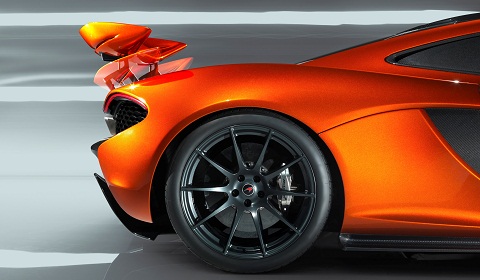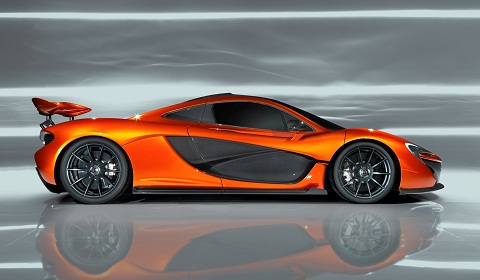Finally, full details have been revealed for the McLaren P1 at the Paris Motor Show. The details are fascinating. The McLaren P1 has one simple goal: to be the best driver’s car in the world on road and track. A production version will be made available within the next 12 months and we can’t wait to see it!
The P1 was designed from the outset to prioritise aerodynamic performance. As a result, the designers spent many hours in a wind tunnel and behind the computer with CFD (computational fluid dynamics) aerodynamic modelling. It produces a staggering 600kg of downforce from well below top speed, five times more than the McLaren MP4-12C. In fact, it’s closer to the GT3 racer than anything else.
McLaren are yet to reveal the engine of choice. Instead, the latest release states that the P1 will have ‘an immensely powerful engine, superb brakes and state of the art suspension controls.’ Power to weight ratio will exceed 600hp per tonne, however, downforce and aerodynamic excellence will be key to package. The downforce will apparently be most noticeable at low speeds though. However, drag coefficient is just 0.34, very low considering the downforce levels.
As you would expect then, every body panel, air intake, and air exhaust was designed to guide in air from the most efficient places and to maximise cooling. The styling is part of this. The unusual door ducts bring in cooling, the low body draws air to the rear wing and the teardrop shap guides air to the rear wing more efficiently.
The wing adjust automatically to boost downforce and optimise aerodynamics. It can extend rearwards by up to 300mm on a racetrack, and by up to 120mm on the road. It uses a DRS system, much like the Formula 1 car to increase straight line speed, but instead of a flap, the P1 adjusts the whole rear wing! Two flaps mounted under the body ahead of the front wheels also adjust performance characteristics by shifting between 0 and 60 degrees.
The rear wing and front flaps work together to boost handling, braking and straight line performance with the rear wing acting as an air brake! A smooth underbody emulates the ‘ground effects’ boosting downforce further. McLaren also fitted a gold leaf heat shield around the exhausts as gold is the ideal metal to reflect heat.
The McLaren P1 uses a mid-engine design with a development of the 12C carbon fibre monocoque and roof structure safety cage. It’s called MonoCage and also serves to guide air into the engine through an integral roof snorkel and air intake ducts, saving weight in the process. All the body panels are carbon fibre, a little known fact is that McLaren were the first company to offer a full carbon body Grand Prix car in 1981 and the first to offer a full carbon body road car, the F1.

The McLaren P1 has large clamshell single-moulded front and rear panels which are attached to the central carbon MonoCage. Aside from two small access flaps in the rear, a front bonnet and the two doors, this is it. It reduces weight and the number of shutlines but we’d hate to even think about replacement costs! All panels include multi-functional scoops and aero parts, while being as thin and light as possible.
The glasshouse was inspired by the canopies of fighter jets, giving the occupants similar sensations to a pilot. The windscreen is deeper than it is wide, creating a feeling of lightness and airiness inside. The lights are a signature part of the car. The LED headlights are extremely small in size meaning more frontal area can be devoted to cooling. At the back, the rear lamps are literally the trailing edge of the bodywork, framing the diffuser and allowing more heat to exit from the engine bay.
Deliveries are expected to commence in late 2013, the year of McLaren’s 50th anniversary. Presumably, the order books are already open! Check out the live photos from our Paris Motor Show McLaren P1 post!
McLaren Automotive Executive Chairman Ron Dennis said:
The McLaren P1 will be the result of 50 years of racing and road car heritage. Twenty years ago we raised the supercar performance bar with the McLaren F1 and our goal with the McLaren P1 is to redefine it once again. Our aim is not necessarily to be the fastest in absolute top speed but to be the quickest and most rewarding series production road car on a circuit’, says McLaren Automotive Managing Director Antony Sheriff. ‘It is the true test of a supercar’s all round ability and a much more important technical statement. Our goal is to make the McLaren P1 the most exciting, most capable, most technologically advanced and most dynamically accomplished supercar ever made.
Chief Design Engineer Dan Parry-Williams notes:
It is engineering design led. Yet it is a striking and handsome car. The P1 reflects McLaren’s core values. It celebrates aerodynamics, great packaging and light weight. It is all about innovative technology. At the very beginning, we sought to develop a car that you could drive to a racing circuit, then press a button and race it. Maximum speed was never a priority. It’s much more technically challenging, and more meaningful, to develop a car that seeks to be the fastest-ever series production car on a racing circuit. That also makes it much more road relevant than just sheer top speed. The priority was high speed performance matched with tremendous composure, which would come mostly from the state-of-the-art aerodynamics. We wanted a car that was benign and predictable at any speed.
In the beginning, we produced a “jellymould” model that reflected the initial concept. It had to be aerodynamically sound and as tightly packaged as possible around the occupants and the mechanical architecture giving it a shrink wrapped-like outer skin surface. It had a more rounded glasshouse, with greater curvature, to improve aerodynamics and visibility, and give the cabin a fighter-jet canopy shape. We wanted the deck of the car to be as low as possible. The teardrop cabin shape also meant you had a lot more air flowing over the cabin to the rear wing. We also tried to minimise tolerances and clearances. There is no “fat” on the McLaren P1.
We have ended up with a car that looks as futuristic as a concept car – except that it will go into production – and with similar aerodynamic properties to a sports racing car. I believe it is a terrific achievement.
































“”It is engineering design led. ..Yet it is a striking and handsome car.” Sorry Dan, but those things are mutually exclusive, as the design demonstrates.
im liking it..oh yeah…ill buy one when it releases.
I think you might have to be selected to get on the list to purchase one, GS is the one to see about that, already got one under his belt